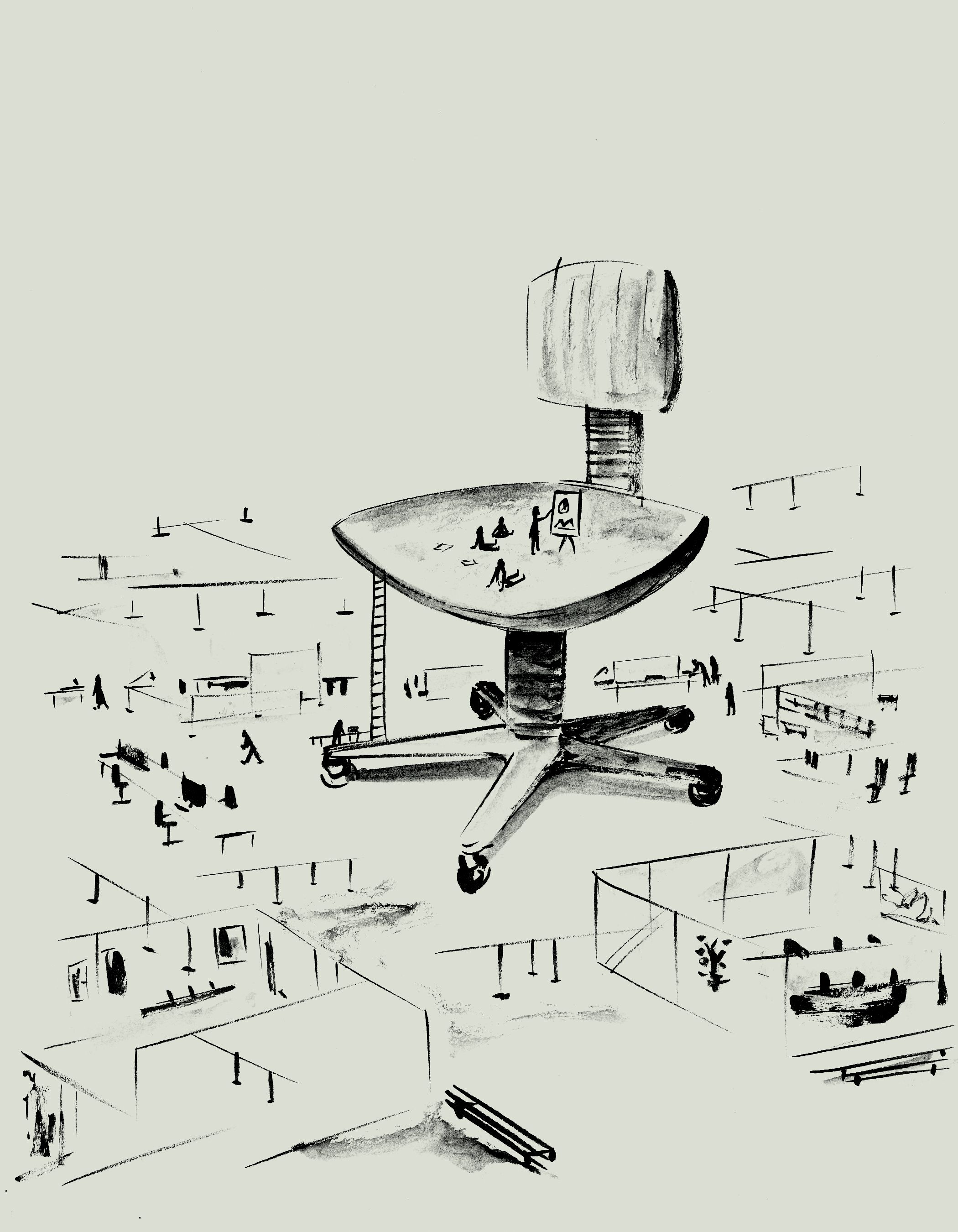 Our lives at work are about to change—again. Just as the addition of PC’s and Wi-Fi re-drew the office blueprint, emerging technologies like robots, virtual agents, artificial intelligence (AI), and the Internet of Things (IoT) promise to radically revise the form and the function of work and the workplace. In the near future, your office will know who you are (if it doesn’t yet) and will be ready to greet you with your preferred lighting and the array of digital tools you need to do your job.
Our lives at work are about to change—again. Just as the addition of PC’s and Wi-Fi re-drew the office blueprint, emerging technologies like robots, virtual agents, artificial intelligence (AI), and the Internet of Things (IoT) promise to radically revise the form and the function of work and the workplace. In the near future, your office will know who you are (if it doesn’t yet) and will be ready to greet you with your preferred lighting and the array of digital tools you need to do your job.
Already, technologies once confined to the realm of science fiction are trickling into our everyday lives. But how can we use these impressive advancements—existing and envisioned—to create a better workplace? And how can they be seamlessly integrated to create a fruitful balance between humans and technology?
As technology in the office becomes omnipresent and omniscient, business leaders and designers are called upon to imagine the kind of future workplace we want to see. We’ve learned a great deal about what makes people productive and happy—and about what impairs our ability to do our best work. How will technology change the way we think about work? How will it change the way work actually happens and how can we plan for change in an office where human needs and values merge with digital interventions and physical space? The answer is not yet clear.
[perfectpullquote align=”right” bordertop=”false” cite=”” link=”” color=”” class=”” size=””]How will technology change the way we think about work?[/perfectpullquote]
Given what we know at present and anticipate for the near future, we can say with some certainty that the office will be a hub of agile, flexible working enabled by intelligent machines and design. Like successful tech firms, successful companies will engineer flexibility, adaptability, and simplicity into the workplace, while also designing spaces and furnishings that display a warmer, more expressive approach and offer a greater range of experiences. Because even as everything around us shifts—as new materials, robotics, AI, and data analytics pave the way for a new kind of office—human beings and the particular “genius” of the human mind remains a constant—at least for now.
Three emerging and evolving technologies that are making promising progress are: soundscaping, daylighting, and affective technology. These solutions combat the difficulties that come along with working in an open office head on, and will continue to develop to new heights.
Keep it Down
 For various reasons—economics among them—the open office isn’t going anywhere anytime soon. However, design and technology can address the inherent acoustic problems that stem from sharing an open space.
For various reasons—economics among them—the open office isn’t going anywhere anytime soon. However, design and technology can address the inherent acoustic problems that stem from sharing an open space.
Noise dampening strategies include angled and “topographic” walls, acoustic textiles, and soundscaping—a technology-based intervention that masks disruptive noise with the murmur of a flowing stream, raindrops, waterfalls, and other natural sounds aimed to soothe. A sense of calm is achieved through speakers that are scattered around the office, and tuned to a discrete volume that does not distract or irritate employees.
While white noise or pink noise can cause fatigue or discomfort, strategic soundscaping can effectively mask chatter, pinging, and ringing with natural sounds that emanate from speakers and are capable of monitoring and adapting to the environment. For instance, if a distracting noise occurs as people gather to talk near a workstation, sensors can pick up the change in decibels and increase the soundscape in that specific area—or, reduce the sound of raindrops in a space where people are quietly working. The system of sensors and speakers will tune the “calming sound shield” to changes in activity and noise, enabling workers “engaged in thoughtful, detailed work to stay in the zone, regardless of what’s happening around them.”
Bright Future
Human beings are highly sensitive to the quality of light in nature and in the built environment. At work, we’ve all suffered from the glare of office strip lighting or the near-blinding slant of late afternoon sun across our desk. The light that pours through office windows dims and brightens continuously, changing with the seasons, the weather, and the hour. While shades, shutters, and blinds offer low-tech ways to modulate light, today smart-tinting glass can be used to adapt to outdoor light conditions, thereby controlling ambiance and temperature, as well as reducing energy use.
Designed for windows, skylights, and partitions, smart glass responds to a tap, switch or voice command. In partitions, smart glass walls can change from transparent to opaque in order to create privacy or lower light levels to enhance the clarity of a wall-mounted LED screen. Some smart glasses use algorithms to automatically adjust tint levels to a building’s location, design, layout, orientation, time of day, and even to the weather conditions outside.
Change the Mood
Affective technology is an application of AI and cognitive computing that is concerned with gathering data to measure emotion and mood. A device with emotion AI programming gathers cues from muscle tension, posture, heart rate, gestures, speech patterns, body temperature and pupil dilation using sensors and cameras to interpret these cues, using deep learning analytical engines. The information can then be used to improve teaching, job training, customer service, counselling, and other activities by measuring levels of attention, engagement, and interest—or frustration, boredom, and stress.
For individuals, there are now wearables designed to monitor emotions, rather than just physical activity or status. Headbands, wristbands and other devices measure breathing and heart rate, speech patterns and brainwaves, and are often paired with apps that offer exercises and guidance to calm the mind. In theory, awareness of one’s mental state along with tangible feedback and guidance helps people to be more mindful and to better manage their moods.
Images: Teknion
John Comacchio is Senior Vice President and Chief Information Officer at Teknion













August 21, 2019
The office is increasingly able to recognise you, but will you recognise it?
by John Comacchio • Comment, Technology, Workplace design
Already, technologies once confined to the realm of science fiction are trickling into our everyday lives. But how can we use these impressive advancements—existing and envisioned—to create a better workplace? And how can they be seamlessly integrated to create a fruitful balance between humans and technology?
As technology in the office becomes omnipresent and omniscient, business leaders and designers are called upon to imagine the kind of future workplace we want to see. We’ve learned a great deal about what makes people productive and happy—and about what impairs our ability to do our best work. How will technology change the way we think about work? How will it change the way work actually happens and how can we plan for change in an office where human needs and values merge with digital interventions and physical space? The answer is not yet clear.
[perfectpullquote align=”right” bordertop=”false” cite=”” link=”” color=”” class=”” size=””]How will technology change the way we think about work?[/perfectpullquote]
Given what we know at present and anticipate for the near future, we can say with some certainty that the office will be a hub of agile, flexible working enabled by intelligent machines and design. Like successful tech firms, successful companies will engineer flexibility, adaptability, and simplicity into the workplace, while also designing spaces and furnishings that display a warmer, more expressive approach and offer a greater range of experiences. Because even as everything around us shifts—as new materials, robotics, AI, and data analytics pave the way for a new kind of office—human beings and the particular “genius” of the human mind remains a constant—at least for now.
Three emerging and evolving technologies that are making promising progress are: soundscaping, daylighting, and affective technology. These solutions combat the difficulties that come along with working in an open office head on, and will continue to develop to new heights.
Keep it Down
Noise dampening strategies include angled and “topographic” walls, acoustic textiles, and soundscaping—a technology-based intervention that masks disruptive noise with the murmur of a flowing stream, raindrops, waterfalls, and other natural sounds aimed to soothe. A sense of calm is achieved through speakers that are scattered around the office, and tuned to a discrete volume that does not distract or irritate employees.
While white noise or pink noise can cause fatigue or discomfort, strategic soundscaping can effectively mask chatter, pinging, and ringing with natural sounds that emanate from speakers and are capable of monitoring and adapting to the environment. For instance, if a distracting noise occurs as people gather to talk near a workstation, sensors can pick up the change in decibels and increase the soundscape in that specific area—or, reduce the sound of raindrops in a space where people are quietly working. The system of sensors and speakers will tune the “calming sound shield” to changes in activity and noise, enabling workers “engaged in thoughtful, detailed work to stay in the zone, regardless of what’s happening around them.”
Bright Future
Human beings are highly sensitive to the quality of light in nature and in the built environment. At work, we’ve all suffered from the glare of office strip lighting or the near-blinding slant of late afternoon sun across our desk. The light that pours through office windows dims and brightens continuously, changing with the seasons, the weather, and the hour. While shades, shutters, and blinds offer low-tech ways to modulate light, today smart-tinting glass can be used to adapt to outdoor light conditions, thereby controlling ambiance and temperature, as well as reducing energy use.
Designed for windows, skylights, and partitions, smart glass responds to a tap, switch or voice command. In partitions, smart glass walls can change from transparent to opaque in order to create privacy or lower light levels to enhance the clarity of a wall-mounted LED screen. Some smart glasses use algorithms to automatically adjust tint levels to a building’s location, design, layout, orientation, time of day, and even to the weather conditions outside.
Change the Mood
Affective technology is an application of AI and cognitive computing that is concerned with gathering data to measure emotion and mood. A device with emotion AI programming gathers cues from muscle tension, posture, heart rate, gestures, speech patterns, body temperature and pupil dilation using sensors and cameras to interpret these cues, using deep learning analytical engines. The information can then be used to improve teaching, job training, customer service, counselling, and other activities by measuring levels of attention, engagement, and interest—or frustration, boredom, and stress.
For individuals, there are now wearables designed to monitor emotions, rather than just physical activity or status. Headbands, wristbands and other devices measure breathing and heart rate, speech patterns and brainwaves, and are often paired with apps that offer exercises and guidance to calm the mind. In theory, awareness of one’s mental state along with tangible feedback and guidance helps people to be more mindful and to better manage their moods.
Images: Teknion
John Comacchio is Senior Vice President and Chief Information Officer at Teknion